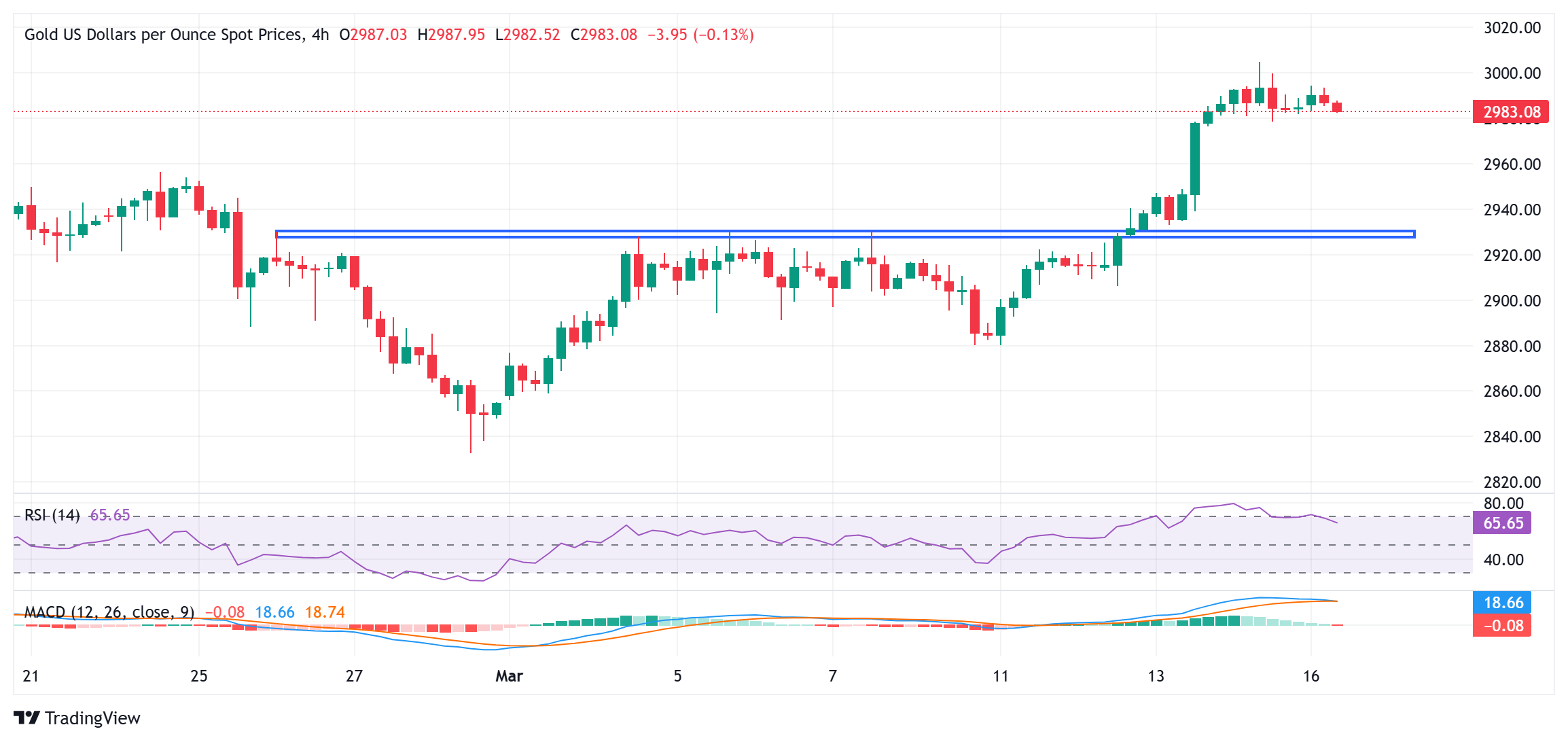Gold prices near all-time highs as rising trade tensions support safe-haven demand.
Markets are betting on multiple rate cuts from the Federal Reserve through 2025, further supporting gold/dollar.
The U.S. dollar hovered near multi-month lows, further supporting the commodity awaiting the Fed's decision.
Gold prices (XAU/USD) struggled to attract any meaningful bids on Monday, even as it remained close to its all-time high - the psychological $3,000 mark hit last Friday. Geopolitical tensions continue to provide support for the safe-haven metal amid escalating trade tensions and concerns about a global trade war. Apart from this, market bets on further rate cuts from the Federal Reserve (Fed) further supported demand for the non-yielding gold.
Meanwhile, the prospect of further policy easing by the U.S. central bank has kept the U.S. dollar (USD) subdued near multi-month lows hit last week, which in turn provided additional support to gold prices. Nevertheless, the generally positive tone in Asian equities, coupled with optimism over China’s stimulus measures announced over the weekend, limited gold/USD gains. Traders also seemed hesitant ahead of the two-day FOMC policy meeting that begins on Tuesday.
U.S. Treasury Secretary Scott Bessent said on Sunday that he is not concerned about the recent market decline as corrections are healthy and normal. Speaking about the possibility of a recession, Bessent added that there are no guarantees. This, along with concerns over the possible economic impact of U.S. President Donald Trump’s trade tariffs, continues to provide support to safe-haven gold prices.
In geopolitics, Houthi leader Abdul Malik al-Houthi said after being killed in a US airstrike that his militias would target US ships in the Red Sea as long as the US continued its attacks on Yemen. In response, the US Secretary of Defense said on Sunday that the United States would continue to attack the Houthis in Yemen until they stopped their attacks on shipping, raising the risk of further escalation of the conflict in the region.
Meanwhile, Israel killed at least nine people, including three journalists, in a drone attack in northern Gaza. The Israeli military said that since the ceasefire came into effect on January 19, its forces have intervened to stop the threat of terrorists approaching its forces or planting bombs. The Israeli military added that the six people killed in the attack were confirmed to be members of the armed faction of Hamas.
Market participants have begun to price in the possibility that the Federal Reserve may cut interest rates several times this year against the backdrop of the Trump administration's aggressive trade policies. This comes on the back of soft U.S. inflation data released last week and signs of a cooling labor market, supporting prospects for further Fed easing.
In fact, Fed Funds futures suggest the Fed could cut rates by 25 basis points each at its monetary policy meetings in June, July and October. This expectation was further confirmed by a University of Michigan survey on Friday, showing that the consumer confidence index fell to a near 2-and-a-half-year low in March. This has put dollar bulls on the defensive near multi-month lows.
China's State Council announced a special action plan on Sunday aimed at stimulating domestic consumption and rolled out measures to boost household income. In addition, Shenzhen, China, eased housing provident fund loan policies to stimulate the property market and clear backlogs. This, in turn, boosted investor confidence and limited any meaningful gains in safe-haven gold/dollar.
Traders are now looking to Monday's U.S. economic calendar - including the release of monthly retail sales and the Empire State Manufacturing Index - to gain some momentum during the North American session. However, the focus will remain on Wednesday’s crucial FOMC decision, which will impact the USD price dynamics and provide fresh directional momentum to the non-yielding gold.

From a technical perspective, the subsequent move after last week’s breakout above the $2,928-2,930 horizontal resistance is seen as a fresh trigger for the bulls. Nonetheless, the daily relative strength index (RSI) remains close to the overbought territory, limiting traders from making fresh bullish bets around the gold price. Therefore, it would be wise to wait for some short-term consolidation or a modest pullback before the next move up. However, the overall picture suggests that the path of least resistance for the gold/USD pair remains to the upside and supports the continuation of the nice uptrend seen over the past three months or so.
Meanwhile, any meaningful corrective decline may now attract new buyers around the $2956 resistance breakout point, below which gold prices could fall to the $2928-2930 horizontal area. The latter should serve as a key turning point. A successful break below could trigger some technical selling and pave the way for deeper losses. XAU/USD could accelerate its decline towards the $2900 round mark, passing through last week's swing low, around the $2880 area.